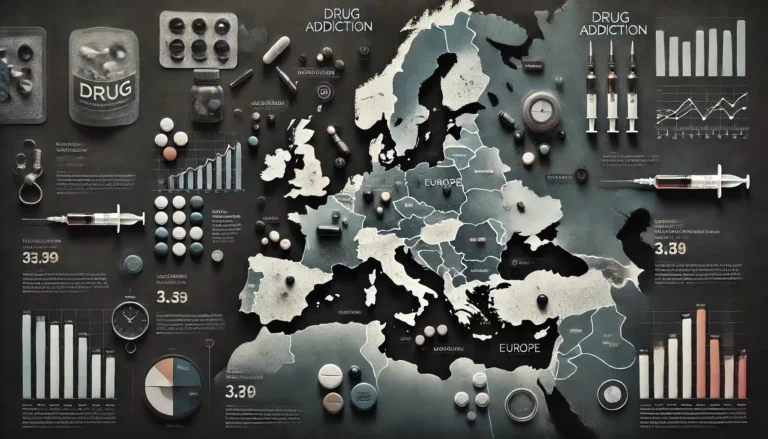
[ad_1]
The opioid crisis in Europe is growing in complexity, with heroin continuing to dominate the market while synthetic opioids, such as fentanyl and its analogs, emerge as potent new threats. The 2024 EU Drug Markets Report, released by the European Monitoring Centre for Drugs and Drug Addiction (EMCDDA) and Europol, provides a comprehensive analysis of the heroin and synthetic opioid market, detailing the health risks, evolving trafficking routes, and potential future challenges.
Heroin in Decline? Why Synthetic Opioids Pose a New Threat in Europe
Heroin’s Ongoing Impact in Europe
Heroin remains the most commonly used illicit opioid in Europe, with an estimated 1 million high-risk opioid users. The European heroin market is valued at over €5.2 billion annually, indicating the persistent demand for this drug. In 2021, EU countries seized 9.5 tonnes of heroin, the largest quantity in 20 years. These figures underscore the strong presence of heroin in Europe, despite the introduction of harm reduction programs aimed at curbing opioid use.
The health consequences of heroin use are severe. In 2021, opioids were responsible for three-quarters of Europe’s 6,000 drug-related overdose deaths, with heroin being a leading factor. Long-term users are aging, adding complexity to public health strategies, as older opioid users present with more chronic health problems.
Afghanistan’s Opium Ban: Future Implications for Heroin Supply
Nearly all heroin consumed in Europe is derived from opium produced in Afghanistan. However, Afghanistan’s opium production has seen a dramatic decline following the Taliban’s 2022 ban on poppy cultivation, which led to a 95% reduction in production by 2023. While the immediate impact on heroin availability in Europe has been minimal, the report warns that a sustained ban could lead to future heroin shortages. Such shortages could open the door for synthetic opioids to dominate the market.
The decline in Afghan opium cultivation from 233,000 hectares in 2022 to just 10,800 hectares in 2023 has raised concerns about the future of heroin availability in Europe. Should the Taliban continue to enforce the ban, experts believe the resulting heroin scarcity could increase the use of more potent and dangerous synthetic opioids, exacerbating the public health crisis.
The Rise of Synthetic Opioids: Fentanyl and its Analogues
Synthetic opioids, such as fentanyl, are becoming more prevalent in the European drug market. These substances are far more potent than heroin, and even small doses can lead to fatal overdoses. The 2024 report highlights how these synthetic opioids are contributing to a growing number of overdose deaths and hospital emergencies across Europe. In countries such as Estonia and Sweden, fentanyl is responsible for a significant proportion of drug-related deaths.
Fentanyl analogs are particularly concerning because they can be mixed with other drugs like heroin or cocaine, often without the user’s knowledge. The increasing presence of these synthetic opioids is a major public health concern, as traditional harm reduction measures, such as naloxone distribution and needle exchange programs, are less effective against these more potent substances.
Changing Trafficking Routes and Criminal Networks
Traffickers are increasingly adapting their methods in response to heightened enforcement measures and geopolitical developments. The traditional Balkan route, which brings heroin through Turkey and Bulgaria into Europe, has seen increased enforcement and stricter border controls, prompting traffickers to shift towards alternative routes.
The Southern route is becoming more prominent, with significant heroin shipments passing through Iran and Pakistan before reaching Europe via major seaports. The United Arab Emirates (UAE) has emerged as a key transshipment hub for heroin, providing both logistical support and avenues for money laundering. Meanwhile, the ongoing Russia-Ukraine war has prompted criminal networks to modify their trafficking routes, further complicating law enforcement efforts.
Public Health and Harm Reduction Efforts
Harm reduction strategies have had some success in mitigating the impact of opioid use in Europe. Programs such as opioid substitution therapy (OST) and needle exchange have helped reduce the number of new users injecting heroin, thereby lowering the risks of HIV and hepatitis C transmission. However, the growing prevalence of synthetic opioids poses new challenges. These potent drugs often require stronger overdose prevention measures, such as fentanyl test strips and more widespread access to naloxone, an opioid antagonist used to reverse overdoses.
Additionally, the report notes the importance of expanding data collection and improving early warning systems to monitor emerging trends in opioid use and trafficking. These systems allow public health authorities and law enforcement to respond more quickly to new synthetic opioids entering the market.
Challenges in Treating Opioid Addiction
Treatment for opioid addiction, particularly heroin, is evolving. Europe’s aging population of opioid users presents new challenges, as older users are more likely to have complex medical conditions. Many long-term users require not just drug treatment but also social support and healthcare for chronic conditions related to long-term substance use. Furthermore, gender-specific issues are emerging, as women who use opioids face more barriers to accessing treatment and are more likely to present with co-occurring psychological or social issues.
Conclusion
The opioid crisis in Europe is evolving, with heroin still posing a significant threat to public health, while synthetic opioids like fentanyl are emerging as an even more dangerous force. The reduction in Afghan opium production and the shifting trafficking routes complicate the landscape further. To tackle this complex issue, Europe must continue to invest in harm reduction, international cooperation, and early warning systems to prevent more overdose deaths and manage the changing face of the opioid market. Without a coordinated response, Europe risks facing an even more devastating public health crisis in the coming years.
Related
[ad_2]
Source link